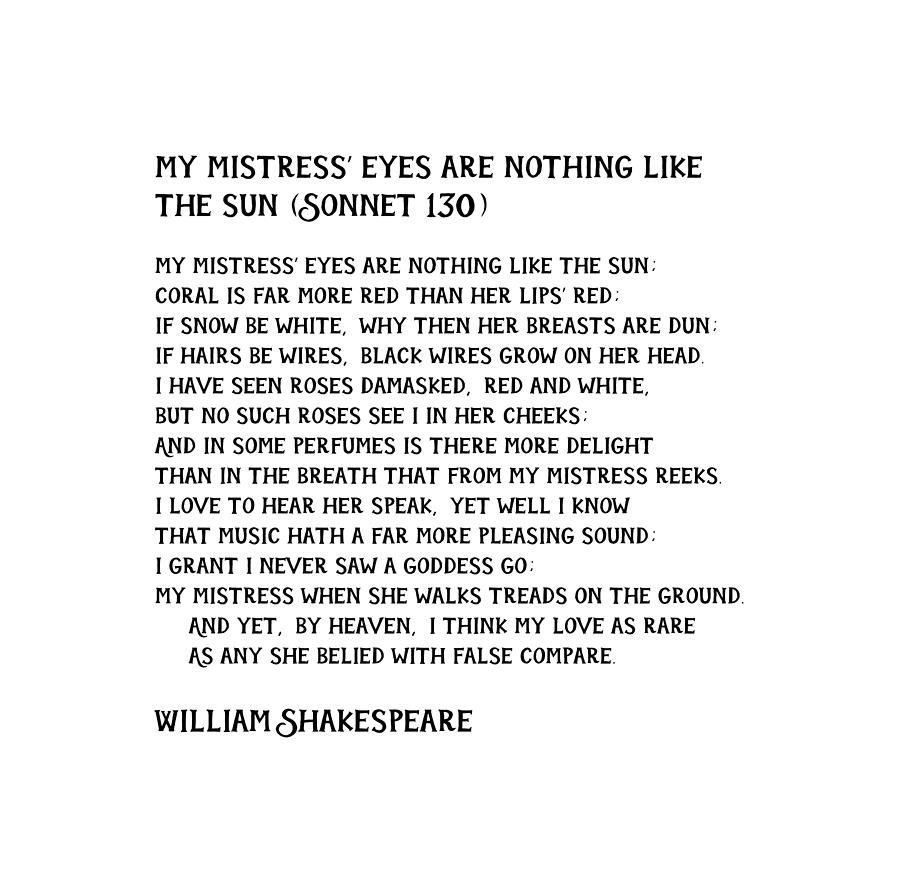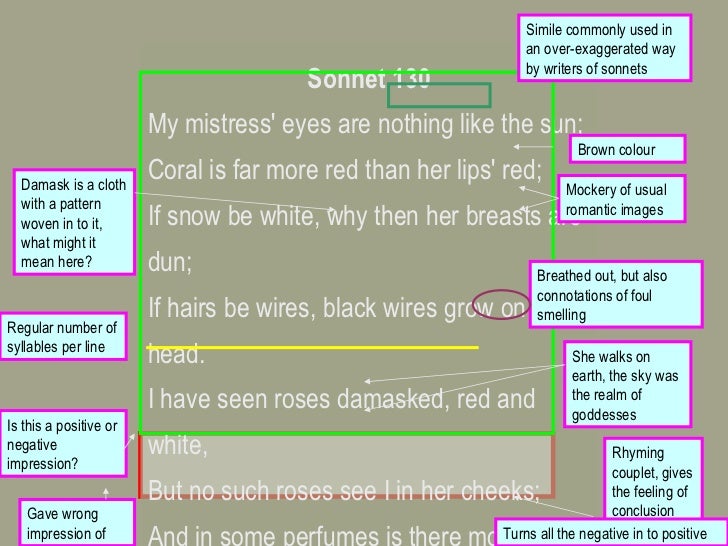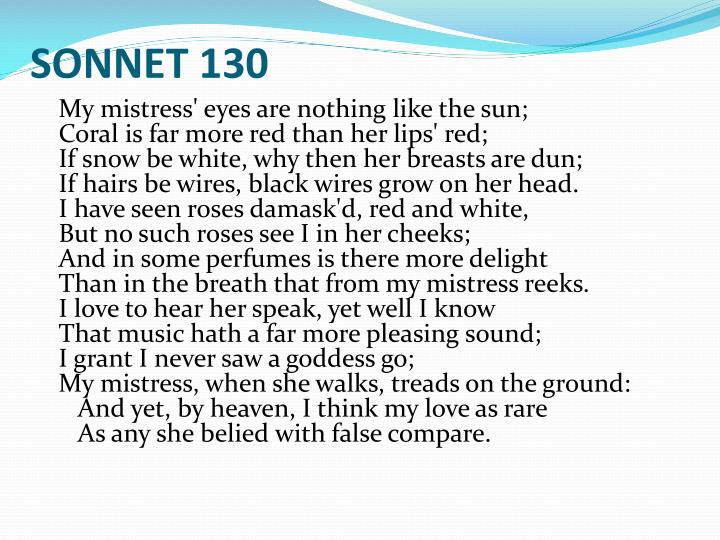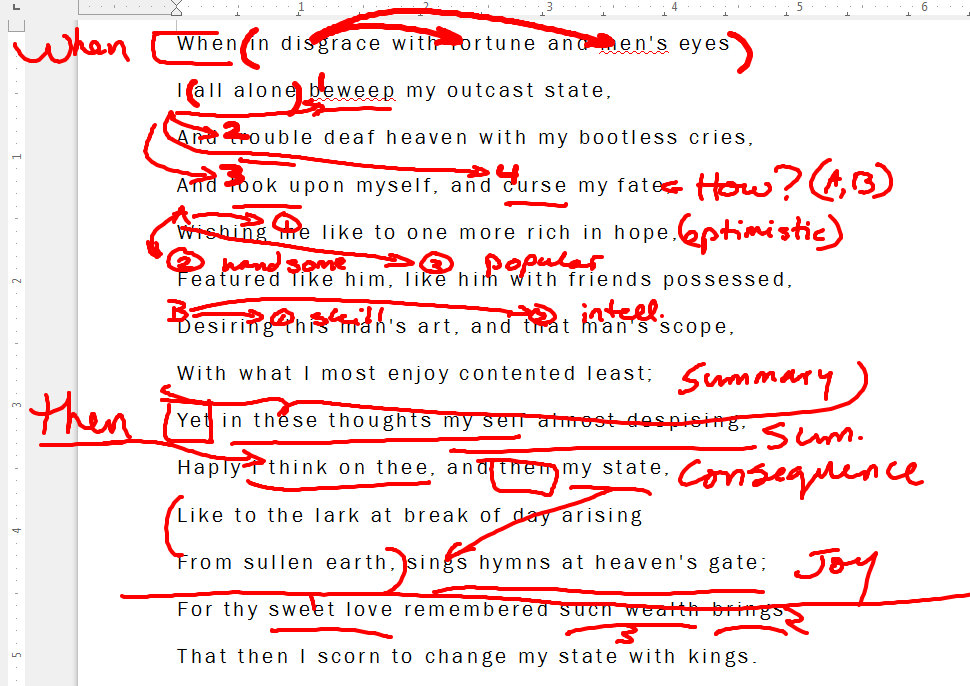
Ligation Temperate Stationary shakespeare 130 Federal
Structure Sonnet 130 is an English or Shakespearean sonnet. The English sonnet has three quatrains, followed by a final rhyming couplet. It follows the typical rhyme scheme of the form ABAB CDCD EFEF GG and is composed in iambic pentameter, a type of poetic metre based on five pairs of metrically weak/strong syllabic positions.
A Retail Life After the MFA Analysis of "My mistress' eyes are
Sonnet 130 Lyrics. My mistress' eyes are nothing like the sun; Coral is far more red than her lips' red; If snow be white, why then her breasts are dun; If hairs be wires, black wires grow on her.

😂 130 poem analysis. Shakespeare’s 130. 20190304
Sonnet 130 is another example of Shakespeare's treatment of the conventions of a sonnet. He follows the conventional form and writes it in fourteen lines. He also uses the conventional iambic pentameter and the division of sonnet into three quatrains and a couplet.

Mrs. Davis' Sassy Classroom Shakespeare 130
"Sonnet 130" was written by the English poet and playwright William Shakespeare. Though most likely written in the 1590s, the poem wasn't published until 1609. Like many other sonnets from the same period, Shakespeare's poem wrestles with beauty, love, and desire.

😂 What does 130 mean. Shakespeare 132. 20190220
Shakespeare's Sonnets Summary and Analysis of Sonnet 130 - "My mistress' eyes are nothing like the sun" What's he saying? "My mistress' eyes are nothing like the sun; / Coral is far more red than her lips' red;" My mistress's eyes look nothing like the sun; coral is far more red than her lips are.

Ligation Temperate Stationary shakespeare 130 Federal
Summary Sonnet 130 is a parody of the Dark Lady, who falls too obviously short of fashionable beauty to be extolled in print. The poet, openly contemptuous of his weakness for the woman, expresses his infatuation for her in negative comparisons.

PPT William Shakespeare’s PowerPoint Presentation ID6956485
Sonnet 130 (1609) by William Shakespeare; William Shakespeare, CC BY-SA 4.0, via Wikimedia Commons. On top of this, William Shakespeare is best known for writing his poetry in iambic pentameter. This is a metrical structure in which there is a specific beat.

Essay on 57
William Shakespeare and a Summary of 'Sonnet 130' 'Sonnet 130' is an unusual poem because it turns the idea of female beauty on its head and offers the reader an alternative view of what it's like to love a woman, warts and all, despite her shortcomings.

😊 130 poetic devices. Rhetorical Devices Shakespeare 130
Sonnet 130 is a poem by William Shakespeare. It is one of his most famous sonnets, which are fourteen-line poems that often deal with themes of love. Sonnet 130 is particularly notable among.

Read 130 by Shakespeare for FREE on any device at
Analysis: "Sonnet 130". William Shakespeare's "Sonnet 130" is a satirical poem and a love poem. The sonnet meets the criteria for the former since the speaker makes fun of conventional beauty norms and how poets tend to idealize women in their works. The poem specifically makes fun of the sonnets of the 14th-century Italian poet.

Analysis of 130 by William Shakespeare Owlcation
Overview William Shakespeare 's sonnets, published in 1609, represent one of the most celebrated collections of poetry in the English language. Consisting of 154 sonnets, these poems explore themes of love, beauty, time, mortality, and the complexities of human relationships.

Pin by Sthandwa Atlegang on poems Poem analysis, English literature
Analysis This sonnet, one of Shakespeare's most famous, plays an elaborate joke on the conventions of love poetry common to Shakespeare's day, and it is so well-conceived that the joke remains funny today. Most sonnet sequences in Elizabethan England were modeled after that of Petrarch.

😂 130 poem analysis. Shakespeare’s 130. 20190304
Sonnet 130: My mistress' eyes are nothing like the sun By William Shakespeare My mistress' eyes are nothing like the sun; Coral is far more red than her lips' red; If snow be white, why then her breasts are dun; If hairs be wires, black wires grow on her head. I have seen roses damasked, red and white, But no such roses see I in her cheeks;

130 (Shakespeare) analysis YouTube
Analysis. Last Updated September 6, 2023. The form and content of Shakespeare's "Sonnet 130" work together to create an appealing poem that makes several important points about human life.

The 130 130 130 By William Shakespeare My
Analysis of Shakespeare's Sonnet 130 - My mistress's eyes Notes dun (3): i.e., a dull brownish gray. roses damasked, red and white (5): This line is possibly an allusion to the rose known as the York and Lancaster variety, which the House of Tudor adopted as its symbol after the War of the Roses.

Online Essay Help amazonia.fiocruz.br
Overview William Shakespeare is the author of "Sonnet 130." The sonnet is one of 154 sonnets that Shakespeare published in 1609 under the title Shakes-spears Sonnets. The first 126 sonnets address a young man, while Sonnets 127-152 focus on a mysterious woman.